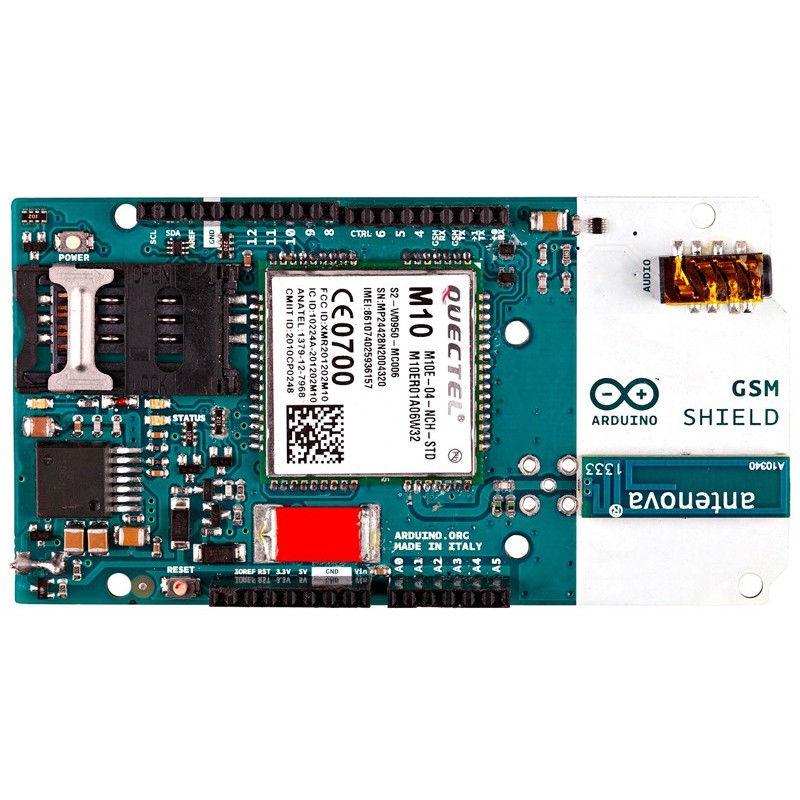- Obecnie brak na stanie




Arduino GSM Shield 2 (z wbudowaną anteną)
Features:
Overview
The Arduino GSM Shield connects your Arduino to the internet using the GPRS wireless network. Just plug this module onto your Arduino board, plug in a SIM card from an operator offering GPRS coverage and follow a few simple instructions to start controlling your world through the internet. You can also make/receive voice calls (you will need an external speaker and microphone circuit) and send/receive SMS messages.
As always with Arduino, every element of the platform – hardware, software and documentation – is freely available and open-source. This means you can learn exactly how it's made and use its design as the starting point for your own circuits. Hundreds of thousands of Arduino boards are already fueling people’s creativity all over the world, everyday. Join us now, Arduino is you!
Description
The Arduino GSM Shield allows an Arduino board to connect to the internet, make/receive voice calls and send/receive SMS messages. The shield uses a radio modem M10 by Quectel (datasheet). It is possible to communicate with the board using AT commands. The GSM library has a large number of methods to communicate with the shield.
The shield uses digital pins 2 and 3 for software serial communication with the M10. Pin 2 is connected to the M10’s TX pin and pin 3 to its RX pin. The modem's PWRKEY pin is connected to Arduino pin 7.
The M10 is a Quad-band GSM/GPRS modem that works at the following frequencies: GSM850MHz, GSM900MHz, DCS1800MHz and PCS1900MHz. It supports TCP/UDP and HTTP protocols through a GPRS connection. GPRS maximum data downlink and uplink transfer speed is 85.6 kbps.
To interface with the cellular network, the board requires a SIM card provided by a network operator.
The most recent revision of the board uses the 1.0 pinout on rev 3 of the Arduino Uno board.
The micro to nano SIM adapter is included in the box.
Power requirements
It is recommended to power the board with an external power supply that can provide between 700mA and 1000mA. Powering an Arduino and the GSM shield from a USB connection is not recommended, as USB cannot provide the required current when the modem is in heavy use.
The modem can pull up to 2A of current at peak usage, which can occur during data transmission. This current is provided through the large orange capacitor on the board's surface.
On board indicators
The shield contains a number of status LEDs:
On board interfaces
The shield comes with a on-board audio jack as well, and it can be used for both microphone and line inputs. It is also possible to make voice calls. You don’t need to add a speaker and microphone.
There are two small buttons on the shield. The button labeled "Reset" is tied to the Arduino reset pin. When pressed, it will restart the sketch. The button labeled "Power" is connected to the modem and will power the modem on and off. For early versions of the shield, it was necessary to press the power button to turn on the modem. Newer versions of the board will turn the modem on automatically.
If you have an early version of the shield, and it does not turn on automatically, you can solder a jumper to the CTRL/D7 pad on the reverse side of the board, and it will turn on when an attached Arduino receives power.
Several of the modem pins are exposed on the underside of the board. These provide access to the modem for features like speaker output and microphone input. See the datasheet for complete information.
Product Code: A000105
Producent BTC Korporacja sp. z o. o. Lwowska 5 05-120 Legionowo Polska sprzedaz@kamami.pl 22 767 36 20
Arduino Uno Rev3 to popularna płytka z mikrokontrolerem Atmel ATmega328 z rodziny AVR, do dyspozycji użytkownika jest 14 linii I/O, 6 kanałów PWM, 6 wejść analogowych. Dodatkowy mikrokontroler ATmega16U4 realizuje komunikację przez interfejs USB. Arduino A000066
Brak towaru
Płytka rozszerzeń z modułem komunikacji 4G/3G/2G i pozycjonowania GNSS. Zestaw posiada wyprowadzenia kompatybilne z Arduino oraz STM32 Nucleo. DFRobot TEL0124
Pakiet Startowy Elektronika z plastikowym organizerem oraz trzema zestawami AVT do samodzielnego montażu. Wyposażony w podstawowe narzędzia niezbędne do pracy
Brak towaru
Brak towaru
Cztero-żyłowy przewód o długości 50 mm zakończony z obu stron wtyczką Qwiic. Sparkfun PRT-14426
Brak towaru
Brak towaru
Brak towaru
Brak towaru
PROSTY STEROWNIK PIECA CO - TERMOMETR R?NICOWY - P?YTKA DRUKOWANA I ZAPROGRAMOWANY UK?AD
Brak towaru
Wyświetlacz LCD TFT 4" z ekranem dotykowym. Wyświetlacz jest wyposażony w interfejs SPI do wyświetlania obrazu i obsługi ekranu dotykowego. Rozdzielczość 480x320 pikseli. Waveshare 4inch RPi LCD (C)
Brak towaru
Brak towaru
Brak towaru
Brak towaru
Brak towaru
Brak towaru
Brak towaru
Brak towaru
Brak towaru

Nakładka do Arduino umożliwiająca dostęp do Internetu poprzez sieć GPRS. Pozwala także wykonywać połączenia głosowe i wysyłać oraz odbierać wiadomośći SMS. Urządzenie ma wbudowane gniazdo do anteny oraz do karty SIM. Arduino A000105
